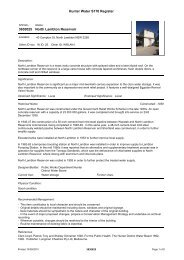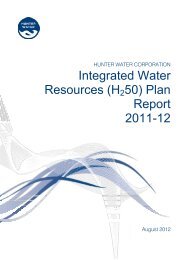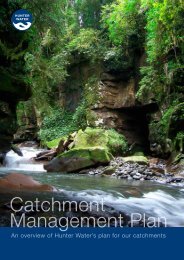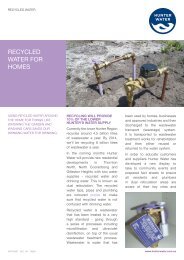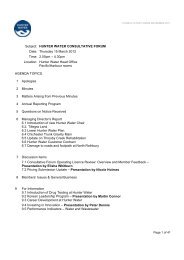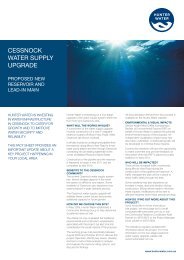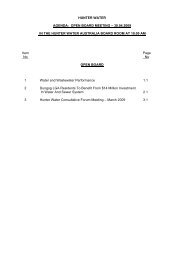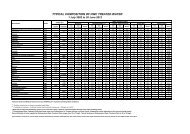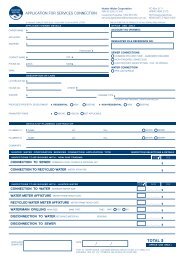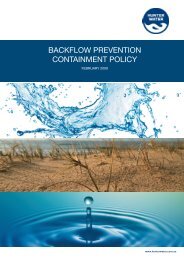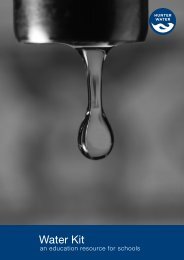Catchment Management Plan - Hunter Water
Catchment Management Plan - Hunter Water
Catchment Management Plan - Hunter Water
Create successful ePaper yourself
Turn your PDF publications into a flip-book with our unique Google optimized e-Paper software.
The current legislative mechanisms forland use planning in <strong>Hunter</strong> <strong>Water</strong>’sdrinking water catchments are:1. The <strong>Hunter</strong> <strong>Water</strong> Regulation 2010:• This legislation defines six catchmentareas in the Lower <strong>Hunter</strong> Regionfrom which <strong>Hunter</strong> <strong>Water</strong> drawsdrinking water supplies.• It addresses potential threatsto drinking water quality fromcatchment activities such asagriculture, extractive industries,sewage disposal, water-basedrecreational activities, andmanagement of waste andpollutants.• The regulation is currently not wellintegrated into local and regionalplanning instruments and regionalawareness of the principles of theregulation could be improved.2. Dungog and Port Stephens LocalEnvironment <strong>Plan</strong>s (LEPs)• The primary purpose of LEPs is tosegregate incompatible land usesthat are thought to be incompatible.They formalise which developmentis allowable in which areas and areadministered by local councils.• Dungog and Port Stephens arethe only councils in <strong>Hunter</strong> <strong>Water</strong>’scatchments and are presentlyremaking their LEPs, applying aStandard Template as stipulated bythe NSW Department of <strong>Plan</strong>ning.The Port Stephens and DungogLEP will be remade by mid 2011.The LEPs do not currently referencedrinking water catchments and thisis an opportune time for change tothese documents.3. The Williams River RegionalEnvironmental <strong>Plan</strong> (REP)• The aim of this plan is ‘to protect andimprove the environmental qualityof the Williams River catchmentthrough the management and useof the catchment’s resources in anecologically sustainable manner’.• It legislates that all developmentmust consider the Williams RiverBest Practice Notes for land use,published in 2005. To this end, itis important to promote the intentof this planning instrument as ithas the capacity to improve waterquality in the Williams <strong>Catchment</strong>.3.2.2 Guidance forminimum water qualityfrom developmentsThe <strong>Hunter</strong> <strong>Water</strong> Regulation 2010requires developments to not pollutedrinking water catchments. Currently,when developments such as subdivisionsin catchments are assessed, counciloften seeks advice from <strong>Hunter</strong> <strong>Water</strong>for the level of stormwater treatmentthat s considered necessary. <strong>Hunter</strong><strong>Water</strong> would be well placed to assistDungog and Port Stephens Councils indeveloping a policy to advise the minimumstorm water treatment necessary fordevelopments within catchments.3.2.3 Recent improvement toplanning controlsDuring the past year, the three legislativeinstruments and processes have been (orare being) improved in the following ways:• The <strong>Hunter</strong> <strong>Water</strong> Regulation2010 has been remade to includedetailed maps of catchments.Prior to 2010, planning bodies wereunsure about the bounds of thelegislated drinking water catchmentareas and therefore sometimesapproved incompatible land uses incatchments.• <strong>Hunter</strong> <strong>Water</strong> has the power toenforce contraventions of theRegulation in the new remake.<strong>Hunter</strong> <strong>Water</strong> has previously hadprovisions under the <strong>Hunter</strong> <strong>Water</strong>Act 1991 to issue infringementnotices but these were not definedin legislation until now.• <strong>Hunter</strong> <strong>Water</strong> has establishedregular training for councilplanners ensuring appropriatereferral of DA’s to <strong>Hunter</strong> <strong>Water</strong>for comment on water qualityimpacts. The high turnover in somecouncil planning staff has meantthat Development Applicationsthat should consider their effect oncatchments do not always do so.Regular contact with councils shouldincrease the appropriateness andnumber of referrals to <strong>Hunter</strong> <strong>Water</strong>for comment. Councils have showna willingness to cooperate if <strong>Hunter</strong><strong>Water</strong> responds in a timely manner.• <strong>Hunter</strong> <strong>Water</strong> has establishedtraining for <strong>Hunter</strong> <strong>Water</strong> staffto ensure appropriate and timelyresponses to referrals from planningbodies.• A new internal process forassessment of DevelopmentAssessment referrals under the<strong>Hunter</strong> <strong>Water</strong> Regulation will likelylead to improved turnaround timesand response rate. <strong>Hunter</strong> <strong>Water</strong>has targeted 100% response rate toexternally reinforce the importance ofthe Regulation to <strong>Hunter</strong> <strong>Water</strong>.• Inclusion of a reference to theRegulation in the new PortStephens and Dungog CouncilLocal Environment <strong>Plan</strong>s. Councilshave agreed in principle to placethe <strong>Hunter</strong> <strong>Water</strong> Regulationrequirements on all Section 149certificates issued within drinkingwater catchments. This move willensure that planners and developersalike are aware that their land fallswithin a legislated drinking watercatchment.CATCHMENT MANAGEMENT PLAN . ssS . 001 . JUNE201030




